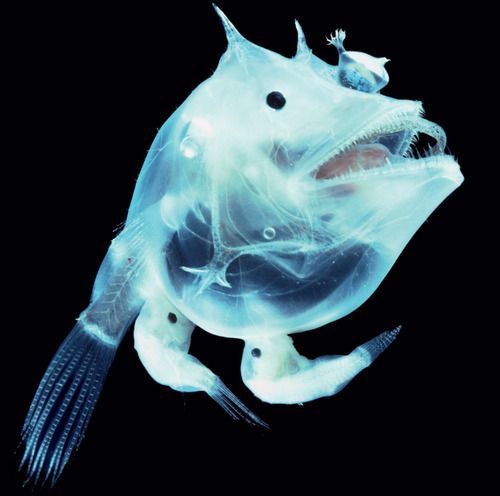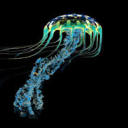Blacksnout Seasnail


Blacksnout Seasnail
Paralipparis copei copei
The Blacksnout Seasnail may not look like a snail, but it does have a slimy, gelatinous substance that covers its body. It can be found at depths between 200 m to 1692 m, and adults grow up to be 17 cm in size (approximately 6.5 in). It also has an elongated body that resembles an eel. Furthermore, it can be seen rolling itself in a loop; this behavior is a defensive posture that makes it appear like a jelly. In the darkness, predators tend to avoid the Blacksnout Seasnail because its often mistaken as a hunter due to its appearance and behavior.
More Posts from Bioluminescentoceangoddess and Others


Wolftrap Angler
Thaumatichthys binghami
The Wolftrap Angler is slightly different from many other species of anglers. It has its bioluminescent lure located inside of its mouth instead of connected to its body. Even though it is intimidating up close, it is only nine centimeters in size. It is found in the deep ocean at 2432m.
Photo credit
https://en.wikipedia.org/wiki/Thaumatichthys_binghami
https://igniteyourcuriosity.wordpress.com/2016/10/22/anglerfish/


Deep-sea white anglerfish
Haplophryne mollis
The Deep-sea white anglerfish is a ghostly white creature found at depths between 1000m to 4000m. The strange bulge between its eyes is a bioluminescent lure. The main fish above is a female and the tiny fish attached to her body are males. Since it is difficult to find mates in the deep ocean, male fish latch onto the female with hooked teeth. Even though the male fish are parasitic, they are eventually reduced to pockets of sperm that are used for reproduction. For all you fellas out there that have a rough time with the ladies, be thankful that you are at least not a bag of gonads floating through the ocean.
Photo credit: https://www.pinterest.co.uk/pin/440297301041956897/
https://news.cgtn.com/news/3d3d414d3559444f7a457a6333566d54/share_p.html

Squarenose Helmetfish
Scopelogadus beanii
The Squarenose Helmetfish is found between 800m to 4000m in the ocean. It received this unique name due to its scales reminding scientists of an armored helmet worn by medieval knights. It also has unusual holes around its face, and the white strands covering its face are sensory canals.
Photo credit: https://www.vistaalmar.es/especies-marinas/peces-extranos/449-que-peces-mas-extranos.html


Pigbutt worm
Chaetopterus pugaporcinus
The Pigbutt worm or the flying buttocks of the sea is spotted floating between 965 m to 1300 m in the deep ocean. It is actually a polychaete (polly-keet) worm species that burrows in the ground as an adult, and floats around the ocean as a baby. The worm feeds itself : by creating a balloon of mucus; collecting particles on the mucus; and then consuming the particles. It is the rarest and thickest worm in the deep ocean, for only ten have been spotted.
Photocredit: https://roaring.earth/pigbutt-worm/


Mid-water Arctic Hydrozoan
Botrynema brucei
The Mid-water Arctic Hydrozoan is a mini-jelly that is transparent with hints of blue. It thrives in freezing cold temperatures and drifts aimlessly in the Artic Ocean. Moreover, it is only 3 cm in size and floats between 900m to 2,600m.
Photo credit: https://en.wikipedia.org/wiki/Botrynema_brucei
http://www.arcodiv.org/watercolumn/cnidarian/Botrynema_brucei.html


Cockatoo Squid
Galiteuthis phyllura
The Cockatoo squid is a highly-specialized oddity of the deep ocean and found at depths between 300 to 1400 m. It is completely transparent, except for its eyes. It also has bioluminescent photophores that are directed downward: this makes it difficult for deep sea predators to see the Cockatoo Squid. It was named after the Cockatoo because it holds its tentacles above its head, resembling the bird. The Cockatoo squid can also get fairly large with adults reaching lengths of 2.7 meters (over 6 ft.)
Photocredit: https://www.americanscientist.org/article/at-home-in-the-dark
https://www.pinterest.com/pin/28710516347382519/

Threadfin Snailfish
Careproctus longifilis
The Threadfin Snailfish resembles a prehistoric tadpole that is ghostly white. The holes in its face are large sensory pores that help them detect changes in the ocean. It is often found at depths between 1900 to 2997 meters.
Photo credit: https://www.timeout.com/singapore/museums/creatures-of-the-deep


Black-devil anglerfish
Melanoncetus johnsoni
The Black-devil anglerfish is a skilled predator that lurks in the darkness. It uses a bioluminescent organ, a top its head, to lure unsuspecting prey into its jaws. Even though these fish are terrifying to look at, they are about the size of a grape fruit. To save energy, they remain immobile in the water, yet they can detect even the slightest vibrations. Since finding a mate is hard at this depth, male fish will attach themselves to a female and slowly dissolve into her tissue; so she is able to use the sperm the male provides at any time. In addition, this is the fish that tried to eat Marlin and Dory in “Finding Nemo.”
Photo credit: https://underthevastblueseas.tumblr.com/post/40882487364/this-female-black-devil-anglerfish-with-her-flabby
https://www.pinterest.fr/pin/574631233709001328/


Giant Bell Jelly
Scrippsia pacifica
The Giant Belly Jelly has 256 tentacles attached to a gelatinous bell-shaped base. Like most cnidarians, the Giant Belly Jelly uses specialized stinging cells called nematocysts to catch its prey. When fish and other prey swim into its tentacles, the sensory projection on the cnidocyte (cell that holds the nematocysts) is activated. Then the nematocysts and barb are released, hitting the vulnerable prey and releasing a toxin into the prey’s body. The Giant Bell Jelly is found at 400 m in the ocean. It is related to the jellyfish, but it is categorized as a Hydrozoa (similar to the Portuguese- man-o-war)
https://vimeo.com/42551565
Photo Credit: https://www.pinterest.cl/pin/467107792572034837/
https://courses.lumenlearning.com/ivytech-bio1-1/chapter/phylum-cnidaria/

Black Medusa
Vampyrocrossota childressi
The Black Medusa is an inky, black hydrozoan that absorbs all light that hits its tiny body. It has a translucent gelatin and a black umbrella; it is also only 1.5 cm in size. Moreover, it is found at depths between 600m to 1500m, and it spends its entire life floating in the deep ocean.
Photo credit: https://www.pinterest.com/pin/488148047080475827/
-
 nightingaleinberkleysquare liked this · 1 year ago
nightingaleinberkleysquare liked this · 1 year ago -
 pepponcase liked this · 2 years ago
pepponcase liked this · 2 years ago -
 lauraatulsa reblogged this · 2 years ago
lauraatulsa reblogged this · 2 years ago -
 lauraatulsa liked this · 2 years ago
lauraatulsa liked this · 2 years ago -
 wildernestt reblogged this · 3 years ago
wildernestt reblogged this · 3 years ago -
 wildernestt liked this · 3 years ago
wildernestt liked this · 3 years ago -
 dr-w0rm liked this · 3 years ago
dr-w0rm liked this · 3 years ago -
 astrotracksuitbattalion liked this · 3 years ago
astrotracksuitbattalion liked this · 3 years ago -
 windyboysworld liked this · 3 years ago
windyboysworld liked this · 3 years ago -
 slackerbee liked this · 3 years ago
slackerbee liked this · 3 years ago -
 creaturedeityendless liked this · 3 years ago
creaturedeityendless liked this · 3 years ago -
 vaguelyexistingcloud liked this · 3 years ago
vaguelyexistingcloud liked this · 3 years ago -
 amb0n3s liked this · 3 years ago
amb0n3s liked this · 3 years ago -
 salvagethevixin liked this · 3 years ago
salvagethevixin liked this · 3 years ago -
 brines liked this · 3 years ago
brines liked this · 3 years ago -
 shinrachamploo liked this · 4 years ago
shinrachamploo liked this · 4 years ago -
 bludahoo liked this · 4 years ago
bludahoo liked this · 4 years ago -
 s6sx liked this · 4 years ago
s6sx liked this · 4 years ago -
 labsforelves liked this · 4 years ago
labsforelves liked this · 4 years ago -
 littlebabydragon-world liked this · 4 years ago
littlebabydragon-world liked this · 4 years ago -
 that-lesbian-phenotype liked this · 4 years ago
that-lesbian-phenotype liked this · 4 years ago -
 robotbutler-waifu reblogged this · 4 years ago
robotbutler-waifu reblogged this · 4 years ago -
 myartrefblog reblogged this · 4 years ago
myartrefblog reblogged this · 4 years ago -
 rabbitsartcorner liked this · 4 years ago
rabbitsartcorner liked this · 4 years ago -
 disableddeinosaur liked this · 4 years ago
disableddeinosaur liked this · 4 years ago -
 intrepideternal liked this · 4 years ago
intrepideternal liked this · 4 years ago -
 fishrfriendsurfood liked this · 4 years ago
fishrfriendsurfood liked this · 4 years ago -
 eden-a-snack reblogged this · 4 years ago
eden-a-snack reblogged this · 4 years ago -
 eden-a-snack liked this · 4 years ago
eden-a-snack liked this · 4 years ago -
 strangelightspyweasel liked this · 4 years ago
strangelightspyweasel liked this · 4 years ago -
 river-monsters-sea-creatures reblogged this · 4 years ago
river-monsters-sea-creatures reblogged this · 4 years ago -
 undertalewolf66 liked this · 4 years ago
undertalewolf66 liked this · 4 years ago -
 oceanetia liked this · 4 years ago
oceanetia liked this · 4 years ago -
 isac24r liked this · 4 years ago
isac24r liked this · 4 years ago -
 uh-oh-its-bird liked this · 4 years ago
uh-oh-its-bird liked this · 4 years ago -
 kaiyobaka liked this · 4 years ago
kaiyobaka liked this · 4 years ago -
 the-southern-lobster liked this · 4 years ago
the-southern-lobster liked this · 4 years ago -
 sammimantha reblogged this · 4 years ago
sammimantha reblogged this · 4 years ago -
 sammimantha liked this · 4 years ago
sammimantha liked this · 4 years ago -
 yuzumaka reblogged this · 4 years ago
yuzumaka reblogged this · 4 years ago -
 lawetlat-la reblogged this · 4 years ago
lawetlat-la reblogged this · 4 years ago

Bioluminescence is a chemical reaction that produces light. Many deep sea animals use bioluminescence. This blog is dedicated to educating the public about the amazing creatures that thrive in the deep sea.
57 posts